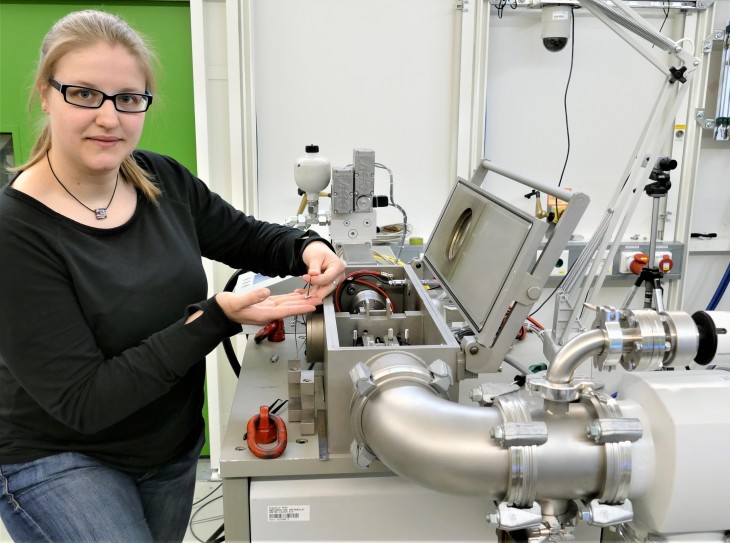Alloy development in ADVANCE
New high-performance material for aircraft
The recently launched ADVANCE project is laying the groundwork for developing new gamma titanium aluminide alloys. These mixtures of titanium and aluminium represent a new class of engineering materials, the behaviour of which has been very difficult to predict thus far. This is something that Katja Hauschildt, materials researcher at the Helmholtz-Zentrum Geesthacht (HZG) is hoping to change. In her experiments to this end she observes the structural properties of the alloys under process conditions (in-situ) in a dilatometer (a precision-temperature test furnace). The results of these experiments are used to improve a database for evaluating the alloys.

Katja Hauschildt at the experimental station at the synchrotron in Hamburg. She holds the sample in her hand - the high-temperature precision furnace is located in the facility on the right. [Photo: HZG/Heidrun Hillen]
In general, gamma titanium aluminide (γ-TiAl) alloys possess a high specific strength, particularly at high temperatures. This is why they’re used in places like the turbine blades of aircraft engines, where they’re employed at temperatures of up to 800 degrees Celsius.
With the new class of gamma titanium aluminides, the structural properties at the temperatures at which they are to be used or produced are not precisely known, which makes it impossible to predict their exact behaviour. It’s for this reason that to date, only two kinds of these high-performance materials have been used in aircraft.
High-performance materials for aircraft
![View into the experiment: The spiral-shaped furnace will heat the metallic sample cylinder (here clamped in the middle). The sample is connected to the apparatus via two thin thermocouple wires. The synchrotron beam guide can be seen above (orange). [Photo: HZG/HEidrun Hillen] View into the experiment](/imperia/md/images/hzg/presse/pressemitteilungen/2019/fittosize__730_0_62c9aa1e47481fb36d77f62823688b8f_advance-probe_2_.jpg)
View into the experiment: The spiral-shaped furnace will heat the metallic sample cylinder (here clamped in the middle). The sample is connected to the apparatus via two thin thermocouple wires. The synchrotron beam guide can be seen above (orange). [Photo: HZG/HEidrun Hillen]
Katja Hauschildt, a scientist in the Metal Physics division as the HZG Institute of Materials Research, explains: “There’s a high demand for new materials in the aircraft industry. Database-based systems and specially designed software are radically reducing the time it takes us to find the right composition of the alloys. Unfortunately, for most gamma titanium aluminides, we don’t yet know enough about the effects individual chemical additives have on the structural properties.” This means that a simulation – i.e. a computer-generated model of an alloy – won’t work with a hundred per cent certainty.
Aufheizen der Legierungsproben liefert Daten
![Analysis of the crystal structure of a material by means of scattering of synchrotron radiation (diffraction). Applied here to determine phase fractions in a titanium aluminide alloy.
Upper left: Scanning electron micrograph (SEM) of the alloy, lower image is a higher magnified transmission electron micrograph (TEM). Upper right: Picture of the diffraction pattern. Shown in blue and green, the two phases present and how they can be clearly identified by the diffraction signal. Titanium aluminide phase A (green) with hexagonal crystal structure and B (blue) with tetragonal crystal structure. In the microstructure images phase A corresponds to the bright areas and phase B to the dark areas. By means of these diffraction measurements, the phase fractions present during heating in the sample can be determined. These results are needed for the database. [Figure: HZG/Maren Wilfert/Katja Hauschildt]
Analysis of the crystal structure of a material by scattering of synchrotron radiation](/imperia/md/images/hzg/presse/pressemitteilungen/2019/fittosize__730_0_e6b60fe1727d45ce055b5f061fcbc90e_hzg_advance-meldung_2.png)
Analysis of the crystal structure of a material by means of scattering of synchrotron radiation (diffraction). Applied here to determine phase fractions in a titanium aluminide alloy.
Upper left: Scanning electron micrograph (SEM) of the alloy, lower image is a higher magnified transmission electron micrograph (TEM). Upper right: Picture of the diffraction pattern. Shown in blue and green, the two phases present and how they can be clearly identified by the diffraction signal. Titanium aluminide phase A (green) with hexagonal crystal structure and B (blue) with tetragonal crystal structure. In the microstructure images phase A corresponds to the bright areas and phase B to the dark areas. By means of these diffraction measurements, the phase fractions present during heating in the sample can be determined. These results are needed for the database. [Figure: HZG/Maren Wilfert/Katja Hauschildt]
In addition to the production process, the elements that make up the alloys also have a significant impact on the properties of the materials. If one knows how the chemical composition of an alloy determines the individual components of its microstructure at various temperatures, it becomes possible to understand and to predict its most important material properties.
Studies on this are being conducted at HZG’s own monitoring station at the German Electron Synchrotron (DESY) in Hamburg. The synchrotron beam is used to bombard γ-TiAl samples with high-energy x-ray light. The advantage of this is that it not only allows measurements to be taken on the surface of the material; it also makes it possible to look inside the material without destroying the sample.
According to Hauschildt: “In our dilatometer, we study the alloy samples being heated up to temperatures of some 1300 degrees Celsius directly in the x-ray beam. With a proper detector, we’re able to make up to ten recordings of the sample’s crystal structure per second.”
The scientist is thus able to obtain accurate information from the sample about the microstructure of the alloy. This data is then supposed to be fed into the database and used to improve simulations.
The ADVANCE consortium
In the ADVANCE project (Sophisticated experiments and optimisation to advance an existing CALPHAD database for next generation TiAl alloys), comprehensive tests are conducted to generate detailed and accurate phase equilibrium data for a series of γ-TiAl alloys and create a database and software tools for developing alloys on computers.
The ADVANCE consortium is made up of four partners from three different countries: As coordinator, Thermo-Calc Software AB (TCSAB), from Sweden; from Austria, the University of Leoben (Montanuniversität Leoben, MUL); and from Germany, the Max Planck Institute for Iron Research GmbH and the Helmholtz-Zentrum Geesthacht Centre for Materials and Coastal Research GmbH (HZG). Also involved in the project is MTU Aero Engines AG, as an additional industry partner and user of γ-TiAl alloys.
The project is being funded within the context of the European aviation research programme Clean Sky 2 under the grant agreement number 820647, with the Helmholtz-Zentrum receiving around 250,000 euros.
Kontakt:

Helmholtz-Zentrum Geesthacht

